Slavonian Family Farm's Slavonsko Zlo Hot Sauce Sales Grow 50%
April the 21st, 2021 - Despite the fact that little good economic news ever comes out of the Eastern part of the country, one Slavonian family farm's Slavonsko zlo hot sauce has gone from strength to strength with its sales.
As Poslovni Dnevnik/Marta Duic writes, behind the Slavonsko zlo hot sauce brand is a line of hot chili sauces and products produced and marketed by the Matko Maltar Family Farm.
According to Maltar, their goal is to offer fans of spicy food supplements something new, innovative products based on natural organic ingredients. They've been developing the brand since back in 2018, the business is a family business, and their chili pepper plantation is next to Petrijevci, a village halfway between Belisce, where the family farm is headquartered, and the City of Osijek. There are also greenhouses in Belisce in which Slavonsko zlo hot sauce is produced.
"In less than a couple of years, we've become available and recognised throughout Croatia, and through our web store, we've had numerous orders from abroad. This whole story with the line of Slavonsko zlo sauces didn't actually even ever arise as a business idea, but out of pure enthusiasm, and only quite a bit later on it did it turn out to have market potential.
How much I can earn isn't really my primary motive because I'm still employed in the family printing house, I have a secure existence, so I practically do two jobs; one in the morning and the other in the afternoon and on weekends. My mission is to redefine the view of most people when it comes to spicy stuff, to profile, present and popularise hot sauce,'' explained Maltar.
The Slavonian family's Slavonsko zlo hot sauces are made with a variety of substances, including gin, hemp oil and more.
In addition to the four basic products; Original, Smokehouse, Jamaican and Candy, they also offer hot Habanero sauce with ginger and pineapple. They also work with other small producers. Behind them is a series of special editions of products created in collaboration with renowned chefs, such as Zlarissa hot chili pepper paste - harisse in the Slavonian way created in collaboration with a member of the Croatian culinary team and chef of the restaurant Lipov hlad Ivan Djukic.
“New products, investments and innovations are our continuity. It all started as an experiment and we're constantly combining things with new peppers, aromas, flavours. As for the ongoing coronavirus crisis, I practically didn't even feel it in terms of doing business, and the primary reason for that is our orientation to the web store distribution channel. The web store achieves brilliant results, and our sales are growing progressively.
As much as 90 percent of our sales take place online, and this year our sales increased by 50 percent compared to the same period last year. Often our main problem is that we don't have enough products, but we started dealing with that by agreeing to buy peppers with two other family farms,'' explained Maltar.
In addition to the Internet, they also sell their products on the doorstep and in a number of restaurants and shops. The family cooperates with about twenty restaurants and street food vendors from all over Croatia. Most of their customers opt for their boxes or stretchers with multiple types of sauces, meaning that more or less all of their products are equally in demand.
"Soon we're going to start with the production of ajvar, and since ajvar is a relatively mild product when it comes to spices, we'll place it on the market not under the name Slavonsko zlo, but instead under a sister brand. We recently agreed for our products to be made available at the Romberg restaurant, which will soon open in Belisce. This is a very ambitious project that aims to showcase Slavonian gastronomy in a much more modern way,'' concluded Matko Maltar.
For more, follow Made in Croatia.
VukovART 2021 to Return Art, Culture and Joy to the City of Vukovar
April 20, 2021 - With a five-year tradition already in place, VukovART 2021 promises a month of fun and exciting activities for Vukovar with visual eye candy as souvenirs to last.
A unique concept in the culture and art of Vukovar, the VukovART festival will be held from May 15 all the way to June 15, writes HRTurizam.
With a five-year tradition, the streets and squares of Vukovar will once again host numerous exhibitions and workshops, debates, children's programs, film, and literary programs, panel discussions, colorful lectures, and concerts. This event, organized by the City of Vukovar and Val Kulture association, co-financed by the European Social fund, promotes Vukovar as a Port of Art, changing the visual identity of the city making it a beautiful place to live. In addition to the local community, tourists also enjoy the eye candy of the city's open-air gallery. Artists Boa Mistura (Spain), BustArt (Switzerland), Jana Brike (Latvia), Mr Woodland (Germany), Victor Splash (Russia), Artez (Serbia), Juandres Vera (Mexico), Kerim Musanović (Bosnia and Herzegovina), Marion Ruthardt from (Germany), and Croatia's own Forest are ten artists who will come this year to give their contribution to the growing visual content of the city.
The festival will be opened by a beloved Croatian band Vatra (Fire), with performances of Mia Dimšić, musical composition CLUE, and vocal composition Watercolor in the following days too. During every larger event of the festival, „a superb craft scene and street food“ offers will be offered to visitors too.
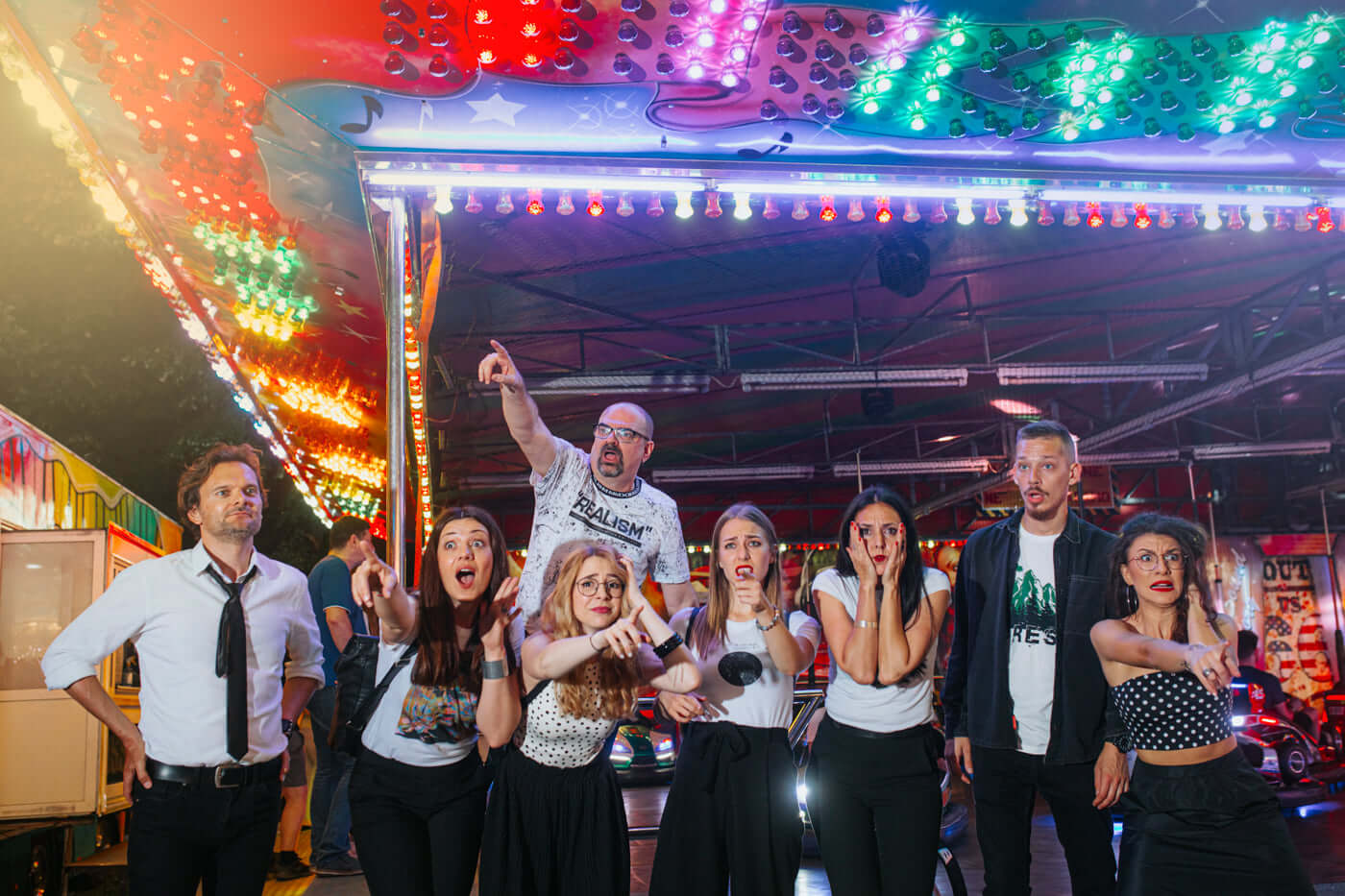
© VukovArt - Art Harbour
Famous Croatian singer from Psihomodo Pop with a neck in painting as well, Davor Gobac will exhibit his paintings and also host Motivational and Art Workshop for children.
„There will also be an active weekend led by the Vukovar Half Marathon, and for a slightly more relaxing activity, a bicycle race will be organized to tour previous works of art“, says HRTurizam article.
Domagoj Jakopović Ribafish, Dusan Bučan, and Robert Knjaz will host travel lectures and the full program and more details can be found on VukovART official website and on social networks.
Learn more about Croatia's festivals on our TC page.
For more about Made in Croatia, follow TCN's dedicated page.
Agriculture Minister Marija Vučković Delivers Three Rural Development Programme Contracts
ZAGREB, 9 April, 2021 - Agriculture Minister Marija Vučković on Friday presented three contracts from the Rural Development Programme worth HRK 8.5 million to beneficiaries in Jarmina municipality in eastern Croatia.
She also attended the opening of "Jarmina", the first kindergarten in the municipality in which HRK 7 million was invested from EU funds and her ministry's Rural Development Programme. It will be attended by 75 children.
Vučković told the press this was the 12th kindergarten in Vukovar-Srijem County built with funds from the Rural Development Programme, for which HRK 56 million was ensured, adding that 200 kindergartens would be opened in Croatia thanks to over HRK 1 billion from the programme.
The 12 kindergartens have been opened in communities with a population of below 5,000.
Vučković said kindergartens were important for keeping young families in villages, adding that her ministry would soon advertise calls for the construction of more kindergartens, farmers' markets, firehouses and community culture centres.
Last year the Croatian EU presidency secured the support of the member states for a transitional regulation to enable continuity of financing until "the whole common agricultural policy reform is adopted," the minister said, adding that the reconstruction and construction of the social infrastructure in rural areas would continue.
Over €5 billion for Croatian agriculture
Vučković announced that Croatia would receive over €5 billion for agriculture in the EU's 2021-27 budget.
She said 12.9% of Croatian farmers and over 20% in Vukovar-Srijem County were under 41.
(€1 = HRK 7.5)
For more about politics in Croatia, follow TCN's dedicated page.
Srijem and Slavonia: A Taste of Happiness
April 3, 2021 - From small snacks to spicy dishes and the most delicate desserts, when it comes to food, Srijem and Slavonia are unsurpassed.
Slavonian small snacks and finger food are even tastier, for starters, if they are from the black Slavonian pig. Gingerbread, kulen, kulen cutlet, švargl, sausage, bacon, cheese, ajvar, and more. Then hearty soup, just removed from the heat, still smoked, then sarma and delicious cookies of all colors and sizes. First of all, brandy, and with every dish, the wine of the Srijem vineyards. A very ordinary day in Srijem and Slavonia will look like a real feast, so if you are a gourmet, be sure to stop by. The invitation is valid indefinitely.
It’s not that it won’t make your cheeks glow and your stomach warm. It has everything you need - a harmony of flavors: it is moderately salty, moderately thick, and somewhat spicy. The noodles melt in your mouth and red ground pepper does not cover the delicate taste of fish. It only lacks fish bones. That is why it was given an honest and straightforward name - boneless fish.
Vecernji List reports, this innovative version of one of the most popular dishes east of Zagreb was designed many years ago at the Dunav Hotel in Ilok and has since become their trademark. This hotel, otherwise a real avant-garde in the traditional Slavonian, Srijem, and Baranja cuisine, is not only known for its innovative fish, but it was also the first in this part of the country to receive a Michelin recommendation. Everyone who has eaten there at least once knows. Super price, top quality, everything is fine and fresh, and for a sweet finish, our recommendation is šnenokli. It may seem too simple to you, but that’s exactly where the charm lies. With an absolute explosion of flavors in such a traditional and everyday dish, you will want to immediately ask for a recipe from the head chef.
Good wines accompany delicate dishes, and those from Ilok, the center of the Srijem vineyards, have seduced the most demanding palates for centuries and are drunk in European courts since the princely family Odescalchi filled them in unique packages in the Old Cellars 200 years before Bordeaux and Burgundy. They are protected from traders and resellers who often confused it with that of inferior quality.
True connoisseurs and wine lovers in Ilok will enjoy the fragrant Traminers, and there is still talk of that Ilok cellars that were drunk at the coronation of Queen Elizabeth II. The grapes for the top Traminers of this most awarded Croatian winery are grown on Principovac, a famous wine-growing position and the country estate of the Odescalchi family, where his first vine was planted in 1710. Since then, this royal variety has not ceased to intrigue the wine world.
In Ilok, you have to walk through its beautiful historical core, visit the church of St. Ivana Kapistrana, the Museum of the City of Ilok in the Odescalchi Castle, the Old Cellars from the 15th and 18th centuries, and, with prior notice, at least two or three more wineries, about twenty of them on the Ilok Wine Road.
A homely, positive atmosphere, which can only be provided in Slavonia and a modern, refined interior, characteristic of fine dining restaurants in major world capitals, is how at first the new Vinkovci restaurant Lu could be described. The award-winning chef, Ana Marija Stanković, is a national champion and bronze medalist at the Culinary Olympics in Stuttgart. Fire burger, homemade smoked sausage, pork fillet, glazed pork ribs, chicken fillet in an almond crunch, french lamb rack, beefsteak, rump steak, perch fillet; you will enjoy its interpretation of traditional Slavonian cuisine; especially if you follow modern trends and above all appreciate quality food.

Restaurant Lu Vinkovci | Restraurant Lu Facebook
Although there are more and more modern restaurants and pubs, Srijem and Slavonia will wish you a warm welcome in traditional, proven good restaurants where dishes are simmered, long and slow, with a lot of heart and a few secret ingredients, just like the daughters-in-law used to do.
The final stop is Sotin, the popular Gondola restaurant, and the picnic area. It is cooked there according to traditional, carefully selected recipes. You will enjoy fragrant Slavonian sausages, the famous shepherd's pie or delicious Šokac steaks with špecli, and the greasy bread and the finest saltines homemade jam owned by Aunt Luca look so good and entice with the scents that even the most notable characters will not resist. And only when you take the first bite, that is the taste of happiness.
For more about lifestyle in Croatia, follow TCN's dedicated page.
VIDEO: Move Your Borders and HeadOnEast to Osijek-Baranja County!
March 27, 2021 - You'll want to HeadOnEast to Osijek-Baranja County after seeing all the region has to offer this year!
HRTurizam writes that the HeadOnEast project, with which the Osijek-Baranja County Tourist Board has already successfully promoted the destination, will take a step forward in the new tourist season.
Namely, as could be heard at this year's first "tourist coffee," or socializing with journalists, HeadOnEast has been standardized, and an agreement has been reached on cooperation with all tourist boards operating in Osijek-Baranja County.
Thus, the Osijek-Baranja County Tourist Board, together with the tourist boards of Bilja, Baranja, Osijek, Draž, Đakovo, Erdut, Donji Miholjac, Valpovo, Bizovac, Našice, and Belišće, presented numerous initiatives and projects with which the system is actively preparing for the tourist season. And according to the program prepared by the tourist boards, there will be interesting manifestations and events in eastern Croatia this year!
As could be heard from the director of the Osijek-Baranja County Tourist Board, Ivana Jurić, the emphasis was on dispersed events. This means that there will be something for everyone, and events will be held throughout the year in different locations. Most importantly, the same visuals will be presented in the entire county in terms of communication.
The meeting began by reading the letters from Slavonian and Baranja citizens with an invitation to move your borders and discover this picturesque destination already in spring. This was the introduction to the new promotional campaign of the Osijek-Baranja County Tourist Board called "Move Your Borders," which started this week at the national level.
The further development of the brand platform HeadOnEast Croatia / Visit Slavonia Baranja was presented, and new visuals for destinations make up the offer in Osijek-Baranja County.
Thus, for the first time, all three Baranja tourist boards act under one visual identity: the Municipality of Bilje - Kopački rit Tourist Board, the Municipality of Draž Tourist Board, and the regional Baranja Tourist Board.
This informally united tourist board, in cooperation with the county tourist board, is organizing a new event called "Month of Baranja cuisine" this spring, in line with current epidemiological measures. From April 10 to May 2, every weekend, an open-air workshop will be held on rural estates for 25 participants to prepare authentic Baranja dishes, while Baranja restaurants will offer old dishes in a new guise.
Projects implemented in cooperation with the Ministry of Tourism and Sports and the Croatian National Tourist Board, such as "Safe Stay in Croatia" and special offers for digital nomads, were also presented.
As the new Law on Foreigners has been in force since the beginning of the year, allowing you to stay in Croatia for up to a year, the Osijek-Baranja County Tourist Board has joined the project to promote the destination as an ideal place to stay for digital nomads, through special programs prepared in cooperation with Golden Slavonia Travel and Maksi Tours, local travel agencies that deal exclusively with attracting guests to Slavonia and Baranja.
Through the offer of congress and team-building programs, the destination was presented to international customers at the MEETEX business fair. This time, the Croatian Congress Industry Fair was held virtually, and the Osijek-Baranja County Tourist Board, Hotel Osijek, and Golden Slavonia Travel presented the destination's offer at a dozen B2B meetings held via the Zoom platform with potential buyers from Israel, Germany, Austria, Finland, Belgium. France and Italy. The interlocutors were representatives of large companies such as Ericsson and travel and event agencies specializing in smaller groups and incentive programs.
They are also actively working on developing new products such as circular cycling routes in the most attractive locations in cooperation with Osijek-Baranja County, which recently submitted a project on this topic to the tender of the Ministry of Tourism and Sports. In the meantime, the City of Đakovo Tourist Board informally joined forces with the municipalities in the Đakovo region and started preparing the first "outdoor" routes.
The director of the Osijek-Baranja County Tourist Board, Ivana Jurić, points out that the goal of all activities and the new campaign is to invite domestic visitors to move to eastern Croatia and Slavonia and Baranja, but also to push the boundaries in the perception of this interesting and yet undiscovered region of Croatia.
For the latest travel updates and COVID-19 news from Croatia, CLICK HERE.
International Poetry Day Croatia: Non-Croatian Poets about Croatia
March 21, 2021 - In honour of International Poetry Day Croatia, TCN's Ivor Kruljac met with non-Croatia poets to share their views on Croatia through their art.
Since 1999 and the 30th General conference of UNESCO, March 21 is recognized as International Poetry Day. As said by the United Nations official website, the date was dedicated to poetry to celebrate „one of humanity’s most treasured forms of cultural and linguistic expression and identity“, which history remembers practiced in every culture on every continent.
„Poetry reaffirms our common humanity by revealing to us that individuals, everywhere in the world, share the same questions and feelings“, states the UN.
Supporting linguistic diversity and an opportunity of endangered languages to be heard within their communities along with encouragement to bring back the oral tradition of recitals, the promotion of poetry teachings and poetry in the media, as well as connecting this ancient art form with other art forms such as music, painting, and theatre, are all goals of the International Poetry Day. And here at TCN, we want to do our part and connect poetry with what we always struggle to report on: Showing all aspects of Croatia.
To the fans of contemporary poetry, it's no secret that poets today are very much alive, productive, and regularly present their work. If not in books then at poetry events, open-mics, and on social networks – either from their private accounts, blogs, or in groups dedicated to this wordy-art.
We asked non-Croatian poets through social networks and private group chats dedicated to poetry who either visited Croatia or know about Croatia to send us poems about Croatia with a promise that the top 5 will be published and authors presented. Now, to be fair, while the author of this article is a poet, that is far from being a legitimate poetry critic and the rest of the TCN's editorial team (at least to public knowledge) aren't even poets. The idea was to pick the poems based on how it resonates with us as individuals who gave the art a chance. The academic acknowledgment is nice, but resonating with the audience, the everyday people, should be the goal of any art publically displayed, right?
To be honest, there wasn't really any competition as, by the end of the deadline, we received only four poems. Nonetheless, the beauty of these poems and great resonation with TCN was there and we are happy to publish these poems and ranked them, from fourth place to the very best. You can decide for yourselves which poem you like best (and the messages you see in their work), but here the four poems that „knocked on the doors of our mailbox“ (metaphorically, quite poetically, speaking).
#4: „Croatia“ by Jesus McFridge
Poets such as Charles Bukowski and Walt Whitman are very well known by their name, but just as in many other arts, poets are no exception in sometimes preferring to use pseudonyms to present their work while keeping their identity unknown and privacy secured. Such is the author that goes by the name of Jesus Mcfridge. Quite active in a Facebook group Poetry Criticism For Cool Cats, he revealed in his application that he is from California and described himself as a „24-year-old American that watches too much television“. He added that his knowledge of Croatia is limited to the country at the 2018 FIFA World Cup, but he has fallen in love with the Croatia national football team's checkered uniforms. Despite never visiting Croatia, after „Croatia's tragic loss in the 2018 World Cup final“, he found himself also crying just as many Croatians did.
„In this poem, I have attempted to capture the feeling of this tragic loss that we have shared together, despite the vast seas that separate us“ concluded Mcfridge in his application.
His bittersweet poem simply titled „Croatia“ indeed brings some painful memories but presented in a short and funny way allows us to look at the past in a brighter way, bring back smiles, and give us the strength to cheer for our Croatia national team as they prepare for the next trophy hunt.
Croatia
They
Almost won
The world cup
But
Mandzukic scored
An own goal.

Jesus Mcfridge © Jesus Mcfridge
#3 „Daniela's song“ by Christian Sinicco (English translation by Daniela Sartogo)
Christian Sinicco was born in Trieste, Italy, and his poetry is published in various anthologies and magazines and an editor of the magazine Argo with which he has dealt with the widest overview of poetry in the Italian dialect from 2000 to the present day. He published three books of poetry: „Passando per New York“ (Lietocolle, 2005), „Ballate di Lagosta“ (CFR, 2014) and „Città esplosa“ (Galerie Bordas, 2017). He won the first Italian Slam Poetry Championship and served as the president of the slam poetry association LIPS - Lega Italiana Poetry Slam (2013-2014) and is the current vice president of Poiéin. He is also active in a global initiative of slam poets organizing the world slam championship which early results can be followed on Twitch.
He participated in numerous book festivals including four festivals in Croatia: Zagreb Contemporary Poetry Festival, Forum Tomizza (in Umag), Pula Book Fair, and Rijeka Book Fair.
His second book of poetry „Ballate di Lagosta“, translates as Lastovo Ballads and it's actually a preview while Sinicco plans to soon publish the full book dedicated to this beautiful Croatian island on the southern coast.
„I was on Lastovo several times. I know a poet from there, Marijana Šutić and I spent a vacation there with other poets such as Ivan Šamija and Silvestar Vrljić“, said Sinicco in his application where he offered a poem from „Lastovo ballads“ which already seen its presentation on a prestigious literary site Versopolis.
„Daniela's Song“ may not bring out the most visual and most explicit Croatian motives, but the discrete and specific localization of Croatia is there all wrapped in a love poem to touch the heart and help us remember the summer sweethearts and romance in Croatia.
Daniela's song
I.
She talks about how beautiful it is without knowing where to go
perhaps into the water of the sun like her cheek
simply necessary as the wet dream
in a wider galaxy if it can be understood,
she seduces you through valleys and dusty vineyards
with eyes towards the bay with the waterfall:
Za Barje the sign said, and so also barked the dog tied
under the cypress – his teethed mouth was the buried reason
the fishermen had left him there – near a house
covered with ivy and blackberries, in which had grown
an apple tree with sour fruits and roses
that only you will taste:
avoiding the asphalt and dirt road holes you followed Daniela
targeting yourself and the asphyxia of your life
that follows the path to erect the intelligence of the species
that on the concept of work has built its republic of theft,
then you saw her dancing on the beach between the warm rocks
and the boat pulled out of the lobster pot, the fishermen are back:
good and evil are triangles of waves that spread
on the sea towards the two islands where we swam
– the fish are not aware of it,
and so the man under the pine and his child
with the mask, another fisherman with the fishing line,
only you maybe on the petals you bite as the words
II.
after quite a while we are outdoors and eat figs
at dusk time on this meadow
sliced on the wooden bowl,
we take the bread and tear it many times
because paradise is close to the fire
and the village to our left rises white in pink
made with scales like the barracuda
Korčula has no intention to leave our sight
I shouted as my usual self
you lit the candle and made me notice
we are not alone, but you can stay calm
slowly also the hut
and its fire have become attractive
calming the natural tension
of a darkening sky, not preventing us
from tasting the happiness
of a grilled fish, of tomato and capers
you are attractive when you smile
with a glass of water on the lips
too quietly they get up,
wanting to be born in the response they seek outside
the people at the tables next to us, and from the cottage
where they grill they come to clear up
a woman and the cook, as in a ceremonial
we ask for the check with the hands
they will be intertwined when we emerge from the field
toward the parking lot where we’ll get in the car
and head out to the highest point
of a series of bends, before descending to the valley
the vault of stars surprises us
we stop everything, propped on pillows of a land
that is still hot, we’re sure
that the star will fall, and it comes true

Christian Sinicco © Daniele Ferroni
#2 „The Lakes of Plitvice“ by Vanni Schiavoni (English translation by Graziella Sidoli)
Born in Manduria, Italy, but living in Bologna, Vanni Schiavoni published five poem collections: "Nocte" (1996), "The Suspended Balcony" (1998), "Of Humid and Days" (2004), "Salentitude" (2006), and "Walnut Shell" (2012). He also published two novels "Like Elephants in Indonesia" (2001) and "Mavi" (2019) and edited the poetic anthology "Red - between eroticism and holiness" (2010). Most recently, he also published poetical plaquette „Croatian Notebook“ which features twelve poems dedicated to six Croatian sites: Plitvice Lakes, Kornati, Šibenik, Trogir, Split, and Dubrovnik. Schiavoni wrote the "Croatian Notebook" after a week-long journey in the summer of 2017. His birthplace Manduria is located in the region of Puglia which is 30 miles away from the Pelagosa (Palagruža), the most distant Croatian island, and his surname originates from the name of the Slavonia region in Eastern Croatia.
„For me, it was not just a holiday trip but a journey in and out of everything that I am, a travel diary through which to bring out the game of mirrors between me and that place, between what I am and where I come from and what I have encountered“, said Schiavoni. This journey impacted him with images of the signs of Italy engraved in stone, mournings of the war, communist history („most heretical Communist party in the east in front of the largest Communist Party in the west“, as Schiavoni puts it) and as he added, „the same Adriatic Sea which gives both of us fishes and earthquakes“.
His poem „The Lakes of Plitvice“ is a lovely description of the mixture, the game, and visual eye-candy of the waters in Croatia's oldest National Park, and it linked with a search for bravery and the encouraging point that good and beauty can defeat evil and change it to something better.
THE LAKES OF PLITVICE
The first day they always plunge down into the same spot
the river rapids that come to the encountering
of the white river with the black river
and the more we think ourselves ready with our shrewd eyes
the fewer the adjectives made available to us before that wonder:
the green rush pushes our pupils towards a wild frenzy
it pushes them inside the tearful torrents by our feet
in the shrouded darkness of the sequential caves
and in the vertical caverns sculpted
as if by a hand capable of it all.
Yet Judas must have passed by this place
and though perhaps not the one with burning lips
a simple Judas must have become lost
in this mysterious grid of remorse.
These lakes fall into lakes as lashings on yielding branches
they flow into other waters and so they rain
endlessly
and perfectly untouched.
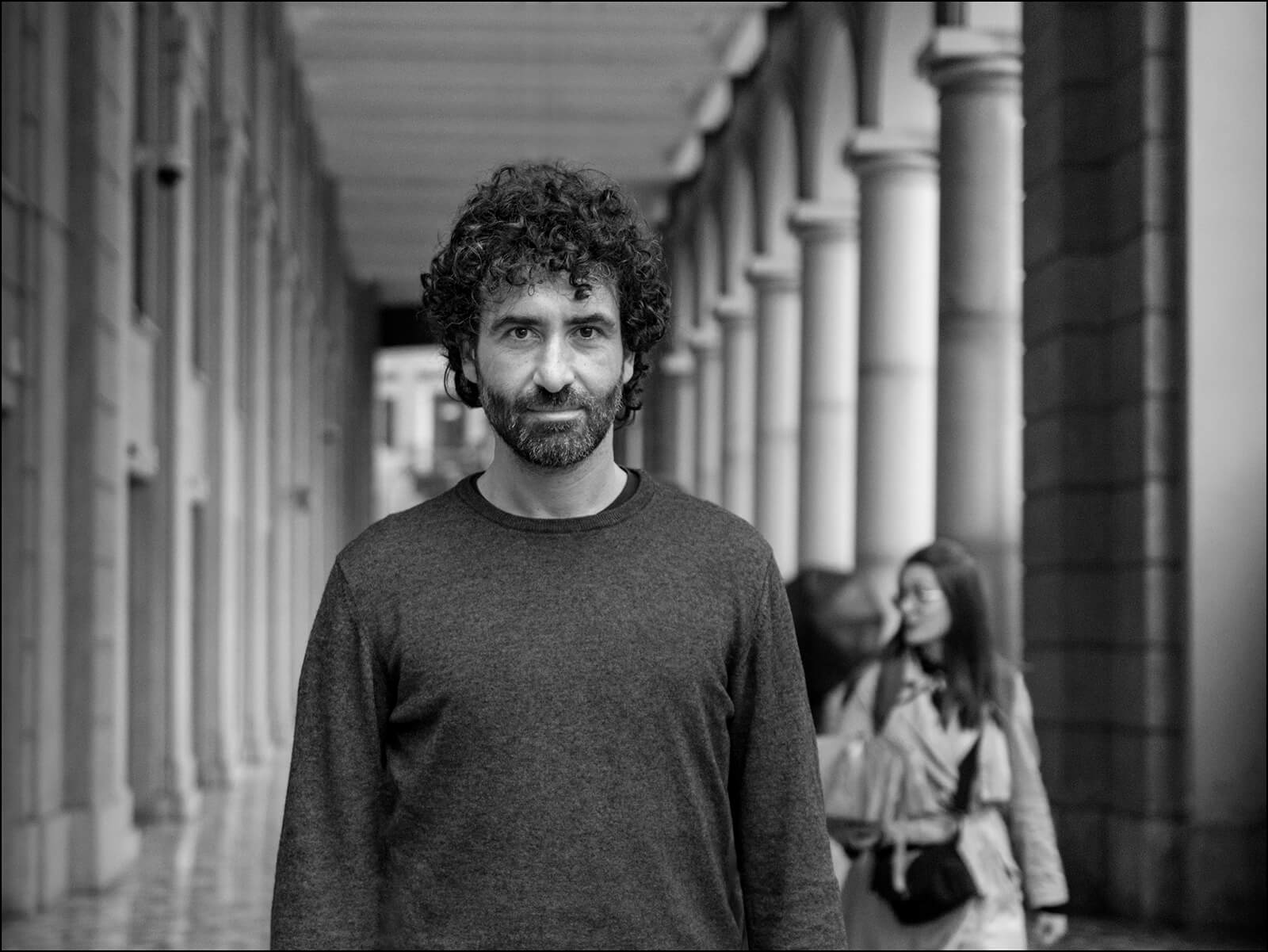
Vanni Schiavoni © Dino Igmani
#1 „Dubrovnik Rock“ by William Vastarella
After Schiavoni and Sinicco, our first-ranked poet is the conclusive evidence there is something so incredible about Croatia it really inspires poetically-inclined neighbors across the Adriatic. Born in Napoli in 1974, William Vastarella is a teacher of Italian Literature, geography, and History. He's has a Ph.D. in semiotics from the University of Bari and writes for several literary and cultural magazines in Italy. He also edited several poetry anthologies as well as semiotic essays. Vastarella visited Croatia several years ago and had a cultural and relaxing holiday on the seaside. „I found her so full of the Mediterranean spirit that I wrote a poem in Italian. I tried to translate it in other words, trying to leave intact the sounds of that memory“, said Vastarella about his poem on Dubrovnik.
The poem „Dubrovnik Rock“ is fantastic in the way, Vastarella visually invokes the images from the history of Dubrovnik (Ragusa) Republic and the relationship it had with Italians at that age with the waves of the Adriatic Sea as the link between Italy and Dubrovnik but also between past and present.
Dubrovnik Rock
Other singers claim to feel
singular vibes in the waves
Nearby this shore,
and so do I.
Ragusa, Dubrovnik
A name is not enough
To trap a soul.
I ask myself
Who’s the other side
Of the other side
As the seawater shuffles.
I touch with my finger
and now I know it’s real
the steel and the wood of the boat
powerful works of man
that wipe out weapons
and I ask no more.
I realize
we have been both
pirates and emperors
centurions and barbarians
through the centuries
each one to the other
a flurry flow
of slavers and Slavs,
slayers and saviors.
Sometimes when the north wind blows,
melting the white in waves,
painting clouds of amazing blues
mirroring the water in the sky,
space seems to become so narrow,
so easy the neighborhood,
then all
the voices of the ancient age
of an ancient game
of thousands lost
in that spot of time,
that spot of sea,
mutate in a mute roar singing
in which merge the rage of riot
and the call for help of a lot
castled in the rock
waiting for a drop of rain to drink
or friend sails on the horizon.
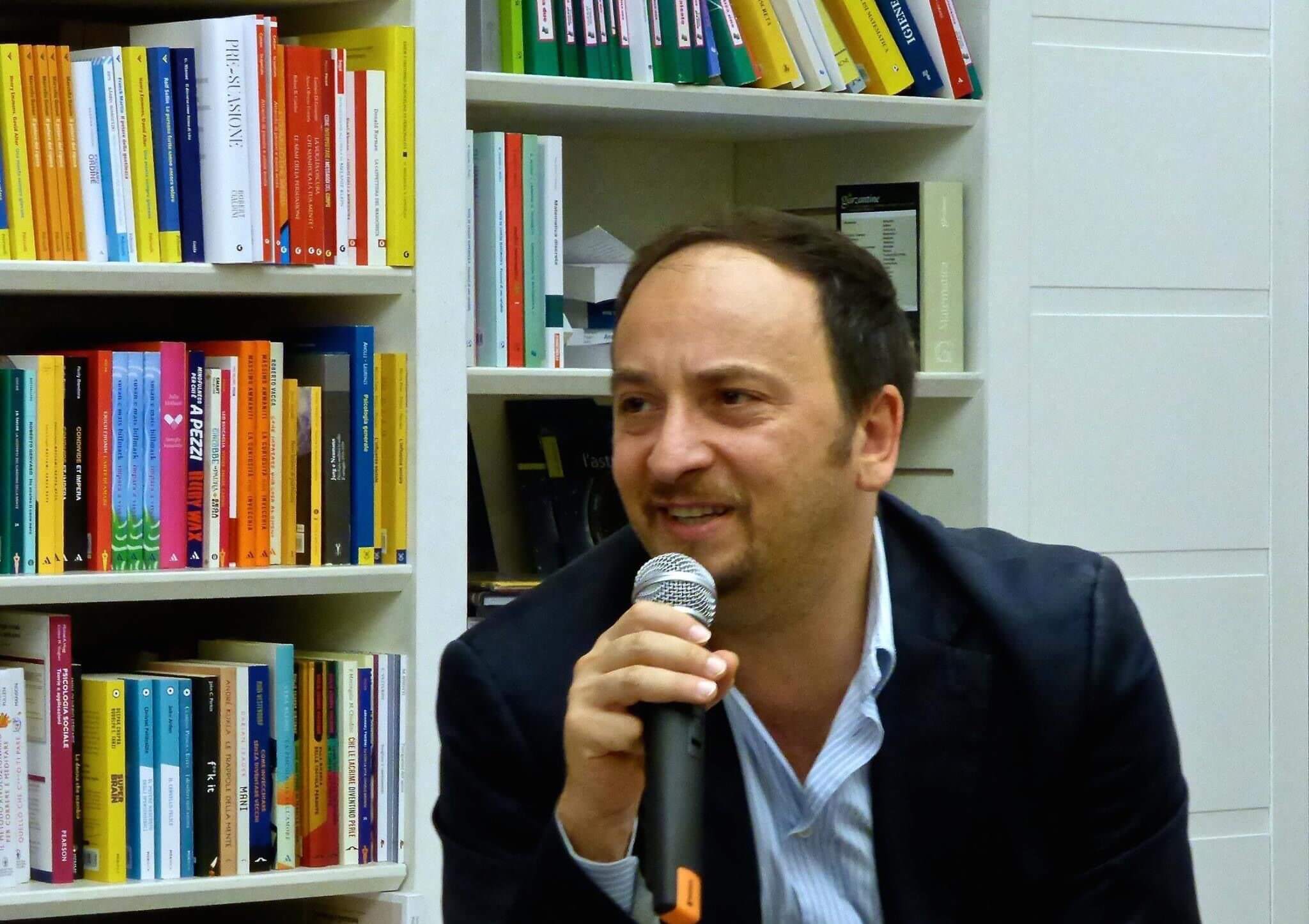
William Vastarella © Vito Signorile
For more about lifestyle in Croatia, follow TCN's dedicated page.
Ivan Anusic: Slavonia's Future Lies in Ecological Production
March the 17th, 2021 - Ivan Anusic has stated that the future of the Croatian east, the former bread basket of the entire region, lies in ecological production. Could moving more towards that lead to the revival of overlooked Slavonia?
As Poslovni Dnevnik/Marta Duic writes, in cooperation with the Croatian Association of Counties, Poslovni dnevnik to see how various Croatian counties stand after the pandemic year, and the first interlocutor among many was Ivan Anusic, the prefect of Osijek-Baranja County.
"The situation isn't ideal, the large projects for which we've provided funds have been slowed down and the realisation has not started at the pace we'd initially planned. However, we found secondary ways of financing and started out with them, but the pandemic left its mark on us, as it has on the whole world,” said Ivan Anusic.
According to Ivan Anusic, this eastern Croatian county was looking for a balance between the economy and the situation with public health, and they wanted at least a part of the economy to function in the given conditions, despite the difficulties involved. Although the large economic systems that can hold up their own weight haven't really been deprived, the catering and hospitality sectors were certainly deprived.
"Slavonia is important for food production and we saw that back in early March (2020) when we were greeted by the first lockdown. Then, we came to the conclusion that food production must be self-sufficient for us who live in Croatia, and later that we must place these products on foreign markets. That must be the priority of our government," believes Anusic.
When they heard that Meggle was leaving, says Anusic, they had to act urgently. Too much politics infecting everything in this part of Croatia let it go down the drain, maybe Osijek isn't our biggest city, but it did have the biggest industry. By shutting down Meggle, we not only lost our jobs but also our tradition and we're glad that we managed to arrange everything with Belje. Unfortunately, there wasn't so much luck for the sugar factory," explained Ivan Anusic, noting that the future of Slavonia should be agriculture.
As he claims, Slavonia cannot build a future on tourism, although intensive work is being done on continental tourism, this area was created for agricultural production, and Anusic sees the future of Slavonia in ecological production. The construction of the Distribution Centre for Fruits and Vegetables has started, and it is a project worth a massive 101 million kuna that will include small farmers and they will be able to store, dry, pack, sort and create added products from their hard work.
"The defeat of every government happens when young people have to leave to get their bread. Slavonia has been communicating this sort of negative story out to the world for many years now, and it was also communicated by those who made it so. We don't need any special help, we just need to be allowed to develop our resources and have those resources in our own hands. Perceptions are slowly changing, European Union (EU) funds are there for us and we have a chance to rise like other Croatian cities and build a story of our own,'' concluded Osijek-Baranja Prefect Ivan Anusic.
For more on Slavonia, follow our lifestyle page.
Slatina Sparkling Wine Find Makes Slavonia Champagne Among Croatia's Oldest
February 13, 2021 – A newly discovered, fully preserved bottle of 'Slavonia champagne' is unique evidence that Slatina sparkling wine is among the oldest in Croatia. Its fascinating history stretches back over 150 years
A completely preserved Slatina sparkling wine bottle from the period from 1864 to 1912 has been discovered during building works of Slatina's new visitor's centre. Found at a depth of two metres, the bottle is physical proof of what was previously known only from records – this 'Slavonia champagne' is among the oldest sparkling wine to have been made in Croatia. © Robert Turkalj
© Robert Turkalj
The discovery of the Slatina sparkling wine bottle is important to the city and its history. Other regions in Croatia have become extremely well regarded over recent years for their production of quality sparkling wines. The production of Slatina sparkling wine briefly disappeared during a period. But, this bottle is evidence that Slatina sparkling wine was among the first to be made in the country. It is the only fully preserved bottle of the 'Slavonia champagne' to exist in the region.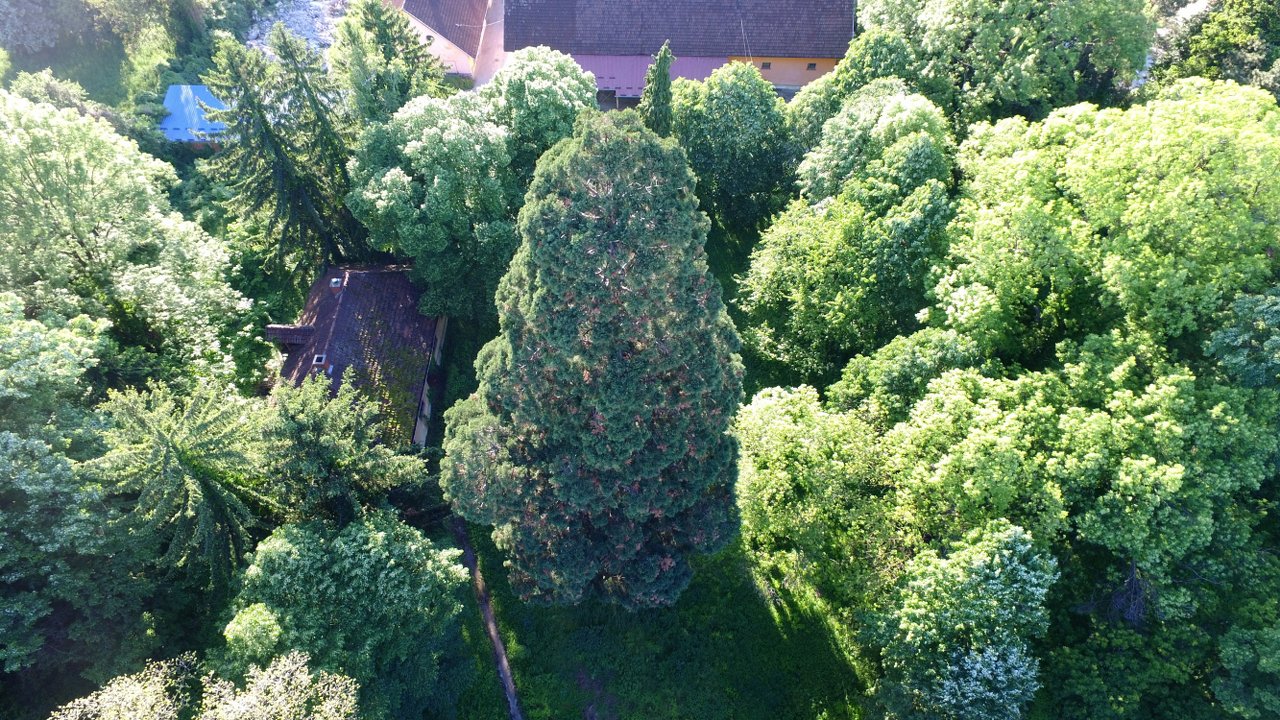 Slatina's nationally protected Giant Sequoia tree (Mamutovac) © Tourist Board of Slatina
Slatina's nationally protected Giant Sequoia tree (Mamutovac) © Tourist Board of Slatina
Of course, we can't really call it champagne – that title is reserved for a type of sparkling wine made in a distinct geographical region in France. But, there are great similarities between Slatina sparkling wine and champagne - similarities that do not exist exactly in other Croatian sparkling wines. Champagne is largely made from the Pinot Noir grape. The found bottle of Slatina sparkling wine was made from the Kadarka grape variety, which has been compared to Pinot Noir.
Both grape varieties are thin-skinned, delicate, easily susceptible to impairment and require a low yield to produce quality wines. Both are tricky to cultivate. For this reason, the Kadarka grape variety is now grown very rarely in Croatia, its place in vineyards taken by more hardy and some imported varietals. But, that wasn't always the case.
History of Slatina sparkling wine
In 1841, the German prince Georg Wilhelm Schaumburg-Lippe bought a property of land in the Slatina area from the Pejačević family. The land contained vineyards, orchards, agricultural fields and large forest areas, including the site of the new Slatina visitor centre where the bottle was discovered. Indeed, trees still line the road of Ulica kralj Zvonimir in the centre of Slatina – the cellar and restaurant of the town's famous Stari Podrum is just a few metres from Slatina's nationally protected Giant Sequoia tree (Mamutovac).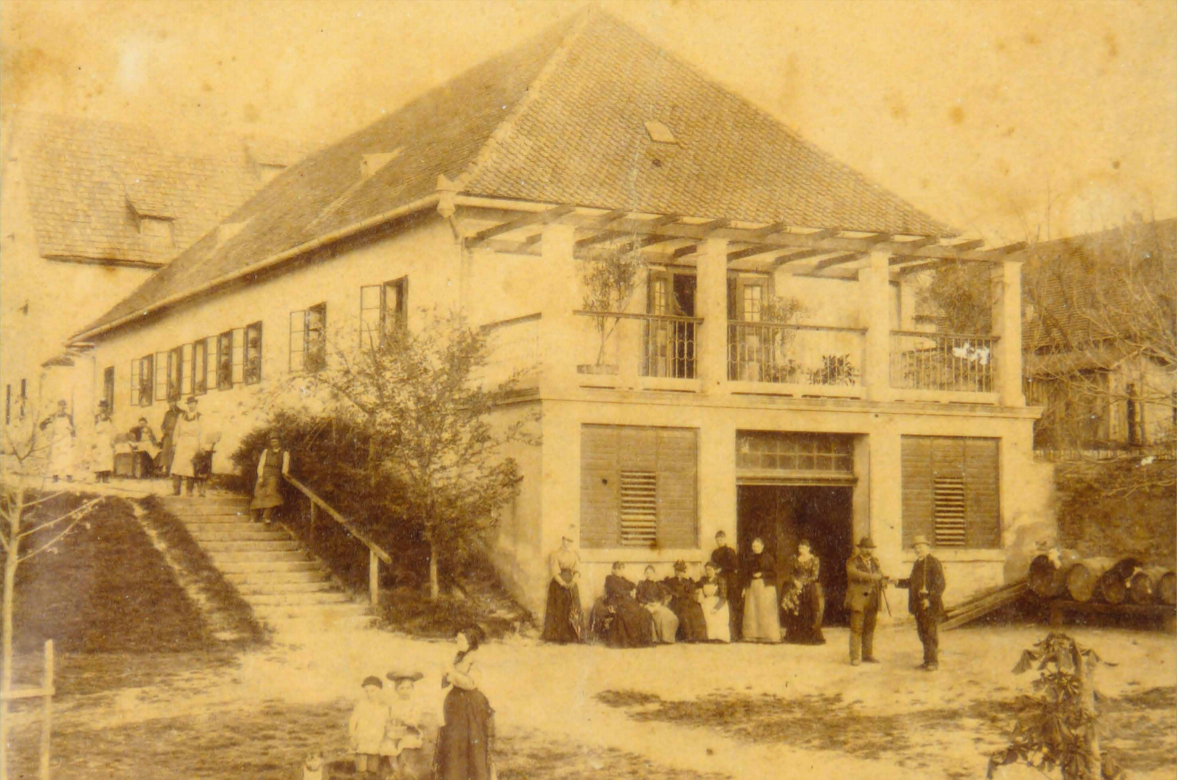 The Stari Podrum cellar, the site of the first-ever production of Croatian sparkling wine, at the beginning of the 20th century © Virovitica State Archives / Slatina Homeland Museum
The Stari Podrum cellar, the site of the first-ever production of Croatian sparkling wine, at the beginning of the 20th century © Virovitica State Archives / Slatina Homeland Museum
Slatina sparkling wine production started in 1864 at the Stari Podrum cellar, using the Kadarka grape variety. Perhaps it was the notorious difficulties of the growing the grape which resulted in slow initial progress for the production, but the enterprise got a massive boost in 1866 with the arrival of a new manager, Otto Rockhror. He rearranged the cellar and production, brought in new equipment and invested in marketing their Slatina sparkling wine. It worked.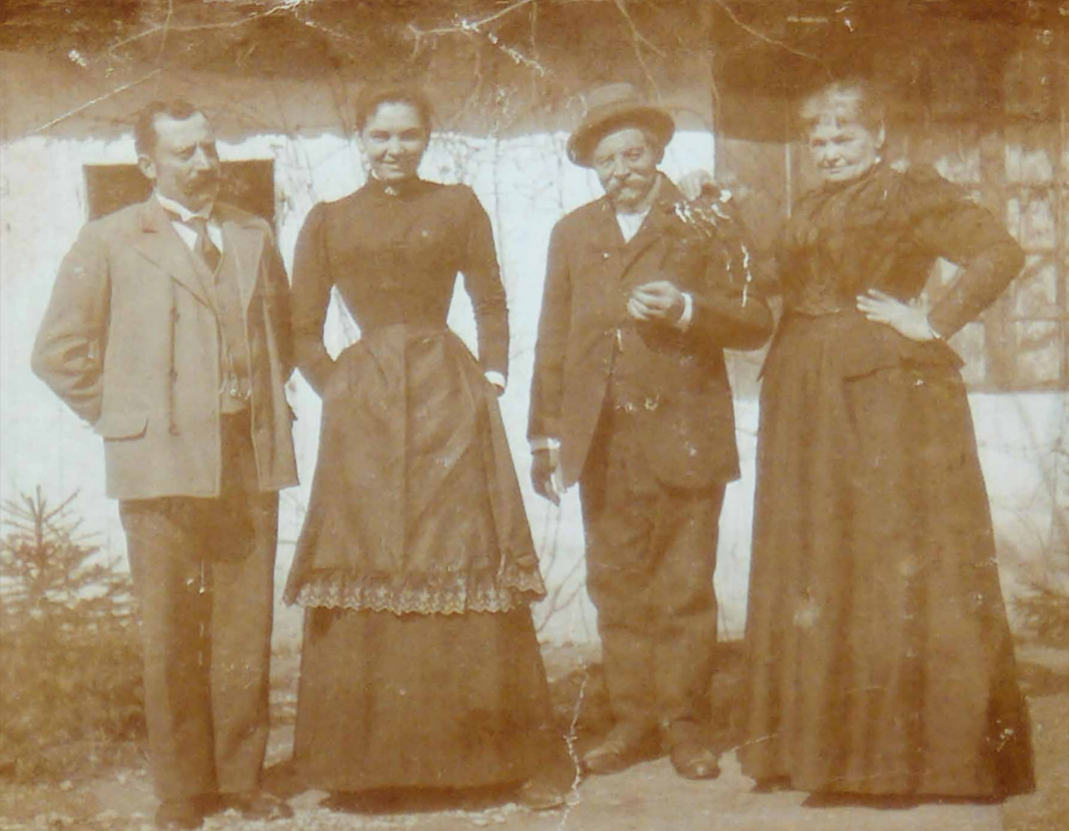 Left to right - Ljudevit Konstantinović, his wife Marija Konstantinović (the daughter of Otto Rockrohr), Otto Rockrohr and his wife Josefina Rockrohr © Virovitica State Archives / Slatina Homeland Museum
Left to right - Ljudevit Konstantinović, his wife Marija Konstantinović (the daughter of Otto Rockrohr), Otto Rockrohr and his wife Josefina Rockrohr © Virovitica State Archives / Slatina Homeland Museum
The quality of Slatina sparkling wine was recognized at the great Economic and Forestry Jubilee Exhibition in Zagreb in 1881 when Georg Wilhelm Schaumburg-Lippe received an honorary diploma and a large medal for domestic sparkling wine and fine wine. The credit perhaps lay elsewhere, considering it was the efforts of Otto Rockhror that were no doubt the cause, but, such were the times. However, Otto Rockhror's achievements with Slatina sparkling wine certainly did not go unnoticed.
At the Science and Industry Fair in Brussels, Belgium, in 1888, Otto Rockhror was awarded a bronze medal featuring the image of Leopold I. He received a further bronze medal with the image of Francis Joseph I in 1890 at the Agricultural and Forestry Exhibition in Vienna and was awarded a silver medal with the image of Franz Ferdinand in 1894 in Vienna by the Association for the Promotion of Agricultural Knowledge. These medals are on display in the Slatina Homeland Museum, donated by Otto Rockhror's great-granddaughter Jasna Nosso. They sit alongside a wooden barrel used in the production of Slatina sparkling wine from 1885 and, now, the latest testament to the history of Croatia's oldest sparkling wine production, the newly discovered bottle, which has been transferred to the museum for preservation, safekeeping and dating. On the left, the bronze medal won by Otto Rockhror at the Science and Industry Fair in Brussels, Belgium, in 1888. On the right, the silver medal with the image of Franz Ferdinand he was awarded in 1894 in Vienna © Virovitica State Archives / Slatina Homeland Museum
On the left, the bronze medal won by Otto Rockhror at the Science and Industry Fair in Brussels, Belgium, in 1888. On the right, the silver medal with the image of Franz Ferdinand he was awarded in 1894 in Vienna © Virovitica State Archives / Slatina Homeland Museum
The production of Slatina sparkling wine from the Kadarka grape did not survive the loss of Stari Podrum cellar manager Otto Rockhror, who died in 1909. Thereafter, ownership of the enterprise was taken over by Count Drašković but, by 1912, production of Slatina sparkling wine had ceased completely and all the production equipment was moved to Hungary. Though the growing of the Kadarka grape variety almost completely died out in Croatia after this, it remains an important part of wine production in Hungary, Bulgaria, Romania and Serbia, where it is grown in Vojvodina, a landscape near-identical to that of Slavonia (indeed, though the heritage of the Kadarka grape is mysterious, the latest opinion is that it is a cross between the Turkish variety Papazkarasi and the Serbian variety Skadarsko and travelled to Pannonia with Serbs who fled north from the Ottomans).
However, the story of Slatina sparkling wine has not only been revived with the discovery of this old bottle. The Stari Podrum cellar still stands in the centre of Slatina today and vineyards still surround the town. The cellar and its wine production were bought by winemaker Ivan Halas over recent years and he has returned the production of Slatina sparkling wine to the historic birthplace of 'Slavonia champagne'. He has since received several awards for his efforts.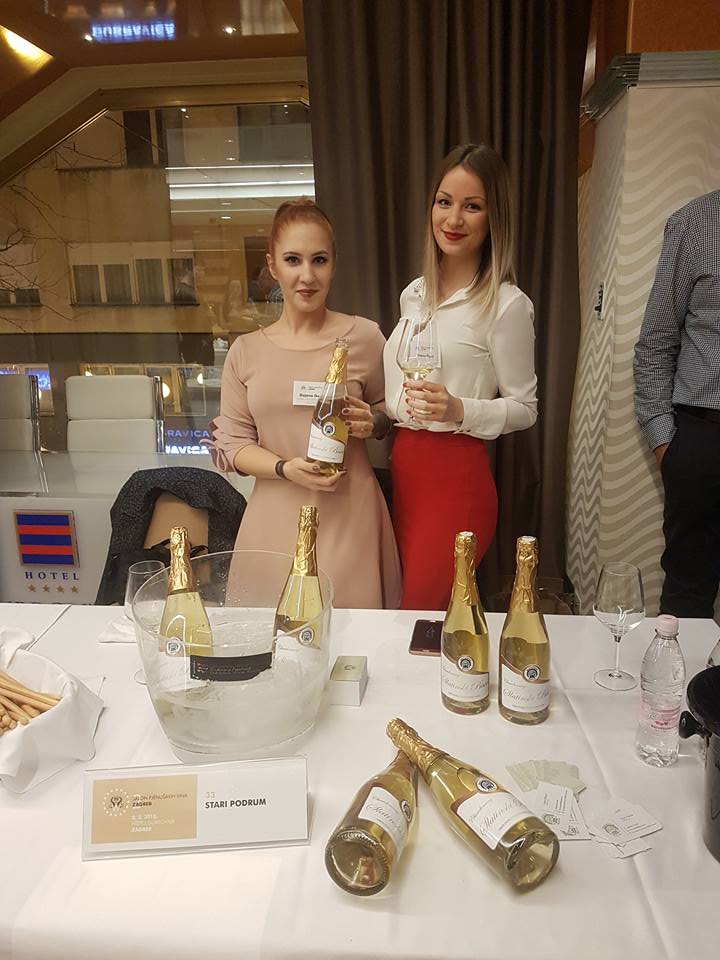 Slatina sparkling wine, revived by Ivan Halas at Stari Podrum, being presented at the 2nd Sparkling Wine Salon at the Hotel Dubrovnik in Zagreb © Tourist Board of Slatina
Slatina sparkling wine, revived by Ivan Halas at Stari Podrum, being presented at the 2nd Sparkling Wine Salon at the Hotel Dubrovnik in Zagreb © Tourist Board of Slatina
“As the Stari Podrum winery does not have adequate conditions for storing the found bottle, we took it to the Homeland Museum in Slatina where it will be stored,” Mr Halas told local news, upon the discovery of the bottle. “Only one bottle was found (so far), although there may be more. It is currently the only fully preserved one in the Slatina area. For now, we assume that it is from the period between 1864 and 1912 - we have no knowledge of the exact year, but the age of the bottle will be determined by experts.”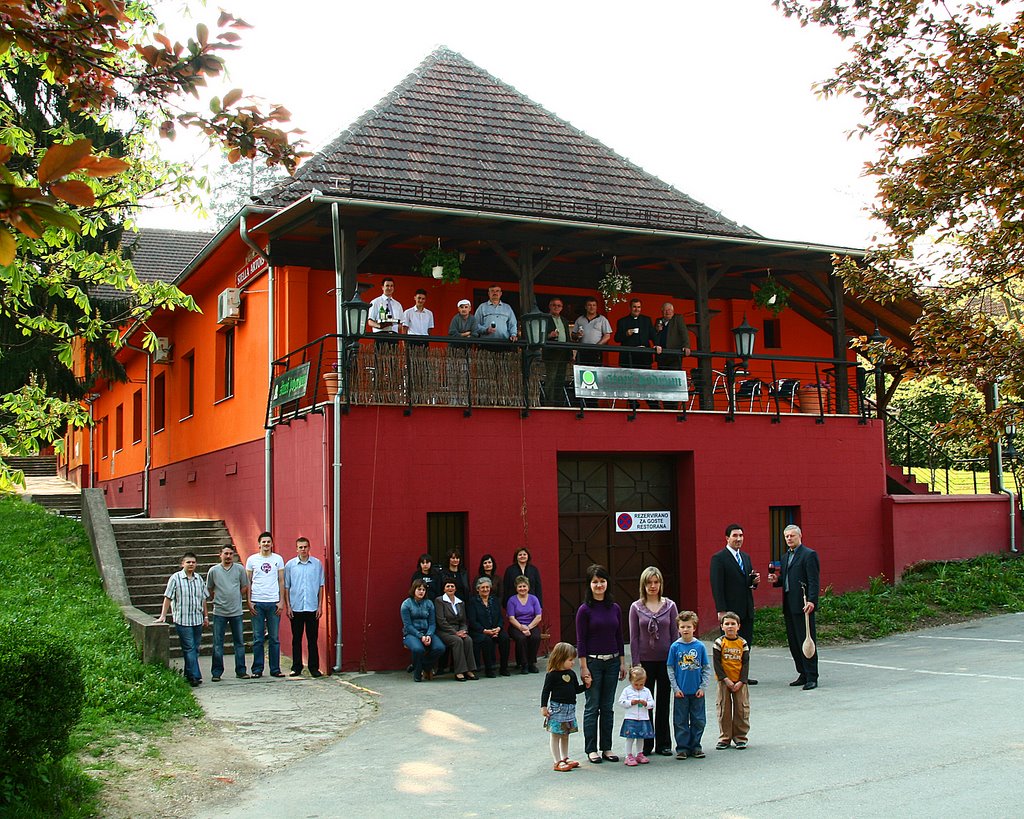 A more contemporary photo of the Stari Podrum enterprise in Slatina © Virovitica State Archives / Slatina Homeland Museum
A more contemporary photo of the Stari Podrum enterprise in Slatina © Virovitica State Archives / Slatina Homeland Museum
Pozega-Slavonia Hunters Send Two Tons of Game to Earthquake Area
February 2, 2021 – In an admirably understated manner, Pozega-Slavonia hunters humbly pitched in to the relief efforts and sent two tons of game to those in the earthquake-affected area of Sisak-Moslavina
It's fair to say that in this day and age, hunters often get a bad rep. There are far more people in the world today who abstain from eating any meat – vegetarians and vegans – than those who go hunting. Changing times. For sure, it wasn't always this way.
In Croatia, hunting associations play a vital role in maintaining the beauty and accessibility of the country's rural landscape. Not that you much hear about this aspect of their undertakings. Perhaps they are typically just rather understated people?
You might easily come to that conclusion when considering the recent humanitarian action undertaken by Pozega-Slavonia hunters. Organised by the county hunting association and county officials, Pozega-Slavonia hunters from each of the region's district societies contributed in an effort to send the game taken by each – mostly deer and wild boar - to the earthquake-hit areas in Sisak-Moslavina County. They so far managed to send a whole two tons!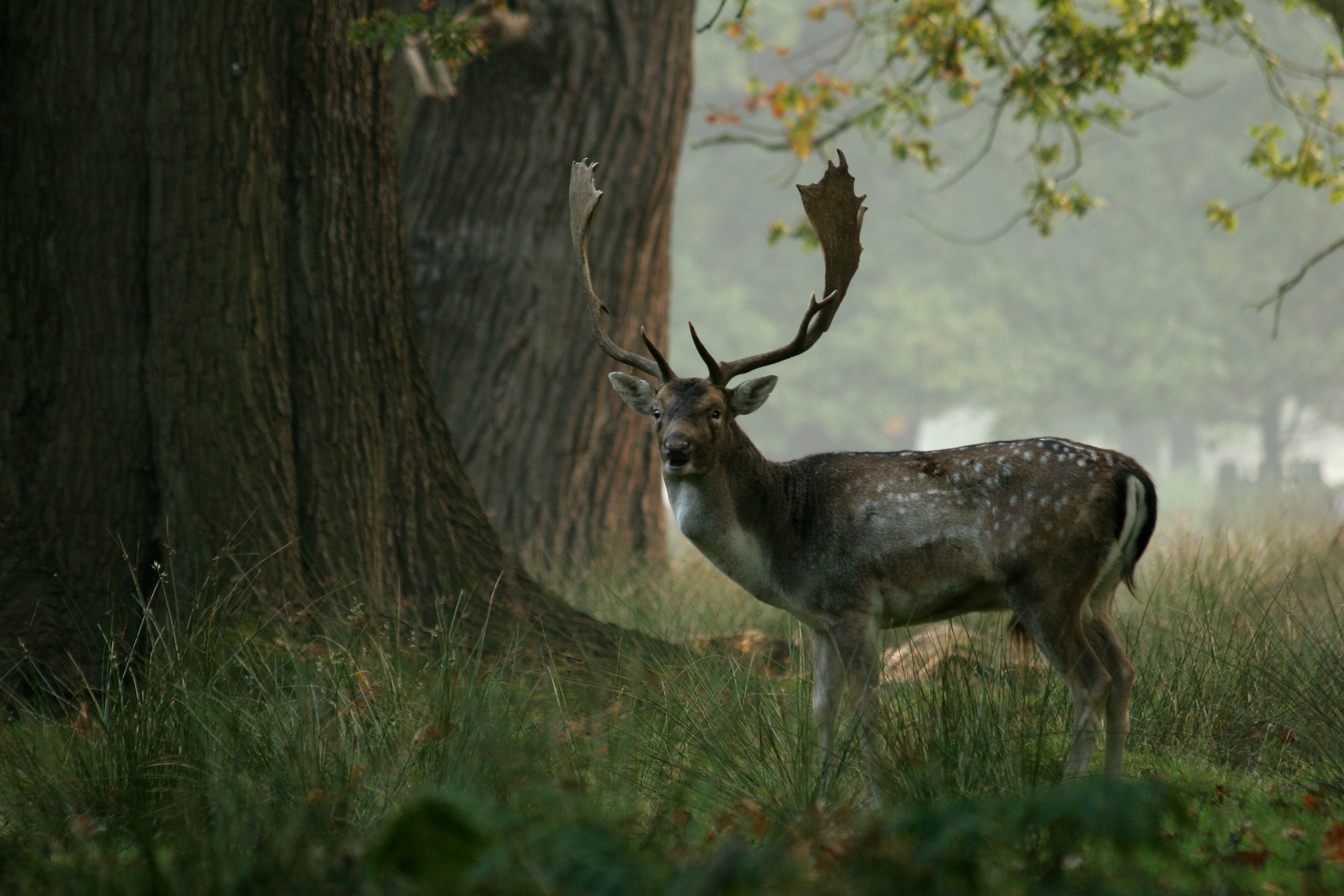
At the same time, Pozega-Slavonia hunters from the county association began collecting funds for the families of those tragically killed in the 29 December earthquake. They have so far collected some 50,000 kunas that will be directed to the intended recipients through the Croatian Hunting Association.
“This is a small help, but undertaken with an open heart,” said a representative from the County, who jointly organised the effort.
“We go to visit friends,” he said, in reference to the delivery of the Pozega-Slavonia hunters game, “and a Slavonian does not go empty-handed. We have loaded more than a ton of meat here (in this shipment), but there will be more because in co-operation with Croatian Forestry, Brod-Posavina County and the Radinje hunting ground, today we will take (in total) about three to four tons of game.”
“(Perhaps) the people of Moslavina will remember Slavonia next time they eat Slavonian čobanac (a local specialty stew, made from game) because she (Slavonia) is always thinking of her (Moslavina),” he concluded.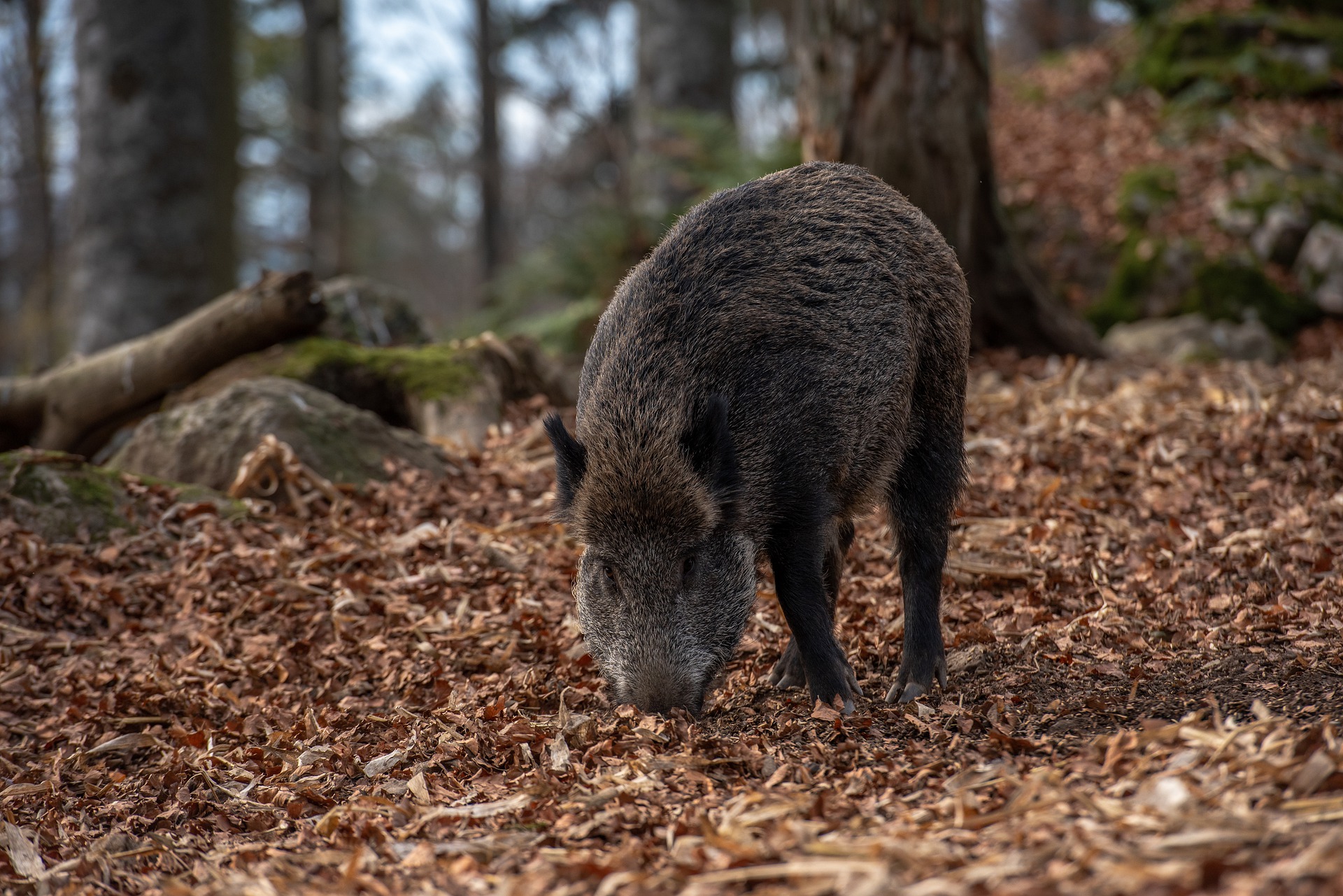
“Lovački savez Požeško – slavonske županije (Hunting alliance of Pozega Slavonia County) was the main organiser,” Mateja Tomasevic, Head of the County office told TCN. “Within it, there are 28 separate societies of Pozega-Slavonia hunters. They all participated in the humanitarian action.”
Among the 28 contributing societies were Hunting Associations 'Fazan' and 'Košuta' from Pakrac, 'Psunj' from Orljavac, 'Šljuka' from Brestovac, 'Jelen', 'Šijak', 'Sokolovac' and 'Sveti Hubert' from Požega, 'Dilj' from Buk, 'Vidra' from Sapna, Čaglin, 'Slavonac' from Kutjevo, 'Strijela' from Bektež, 'Papuk' from Biškupci, 'Sokol' from Bučje, 'Seljak' from Jakšić, 'Vepar' from Kaptol, 'Krndija' from Našice, 'Vranovac' from Vetovo, 'Šljuka' from Pleternica, 'Fazan' from Ruševo, 'Vražjak' from Sesvete, 'Sjeverni Dilj' from Seoce, 'Slavuj Gaj' from Poljana and 'Kuna' from Paka. Over 1300 residents of the county belong to one of the Pozega-Slavonia hunters associations.
Bravo!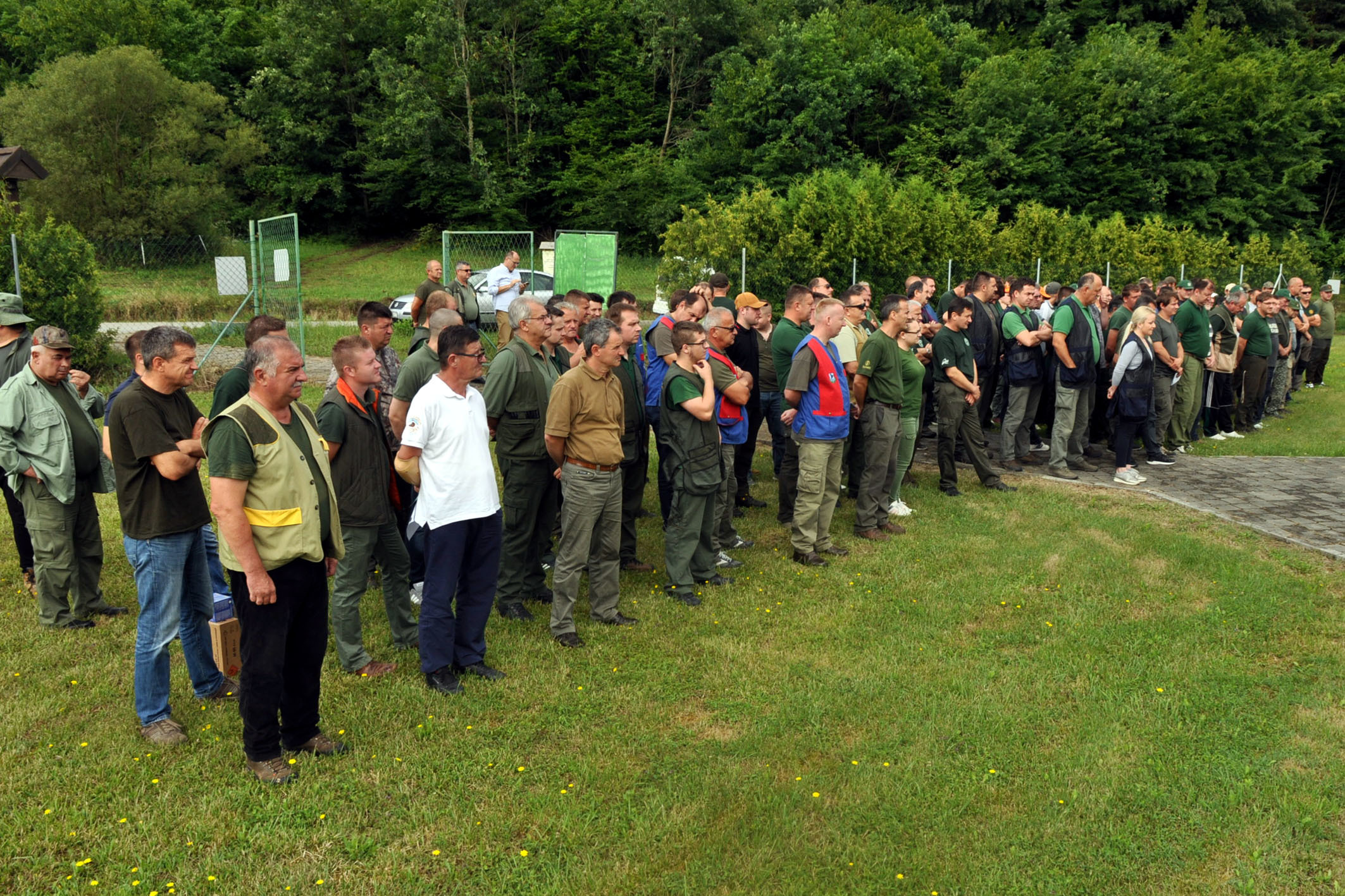 Some of the members of the Hunting Associations of Pozega-Slavonia County © Hrvatski Lovački Savez
Some of the members of the Hunting Associations of Pozega-Slavonia County © Hrvatski Lovački Savez
For the latest travel info, bookmark our main travel info article, which is updated daily.
Read the Croatian Travel Update in your language - now available in 24 languages
Join the Total Croatia Travel INFO Viber community.
BREAKING NEWS: Man Throws Explosive in Pakrac at Two Men
January 27, 2021 – At around 9.20 am this morning, a man threw an explosive in Pakrac at two other men. The two men were injured and have been taken to Pakrac hospital
At around 9.20 am this morning, Wednesday 27 January 2021, a man threw an explosive in Pakrac, in Jana Žiške ulica. The explosive in Pakrac struck two other men. The two men were injured and were taken immediately to the Pakrac hospital. One was later transferred to Zagreb.
Details regarding the severity of the two men's injuries were released by the hospital. They said the least injured man was treated for wounds all over his body and that he has suffered damage to his eardrum, but he is not in mortal danger. His colleague did not fare so well. His injuries were so severe that the decision was made to transfer him to KBC Zagreb. He was sent there at around 1pm. He underwent surgery there. Shrapnel had damaged his legs and pierced both his abdomen and head in several places. His condition going into the night was described as stable.
The two men injured by the explosive in Pakrac are employees or sub-contractors of the national electricity supplier HEP. They are a 52-year-old and a 55-year-old. They came to the house of a 71-year-old from Pakrac with another HEP colleague to turn off the electricity, and the 71-year-old threw a bomb at them. It was necessary to take the two men with the greatest injuries to hospital immediately. The third HEP colleague received minor injuries from shrapnel caused by the blast. It is the 52-year-old man who was in a critical condition. He is a popular local man. He also lives in Pakrac. Nearby houses were damaged in the explosion, police said.
Following the incident, the 71-year-old perpetrator locked himself inside the house. Police managed to arrest him after a while.
The national electricity supplier HEP released a statement about the attack which used an explosive in Pakrac
The statement reads:
"On January 27, 2021, at around 9.15 am, three workers of HEP-Operator distribucijskog sustava doo, Elektra Križ, were attacked with an explosive device while disconnecting electricity, at the order of the supplier, at a metering point in Pakrac.
Two workers were injured in the attack and were given emergency medical assistance.
We will be able to give more information about the circumstances of the event after the police investigation.
The Management Boards of HEP dd and HEP-ODS, the leadership of the HEP Workers' Union and the Association of HEP Veterans are appalled by this event and strongly condemn the attack on HEP employees who performed their regular work properly.
HEP Group employees share their indignation and concern with the families and colleagues of the attacked workers"
Pakrac is a town in western Slavonia. It lies around 50 kilometres to the west of where the tragic discovery was made on Monday 25 January of the bodies of two local men found frozen in the snow.
TCN will be updating this story as and when we get more and relevant information.


